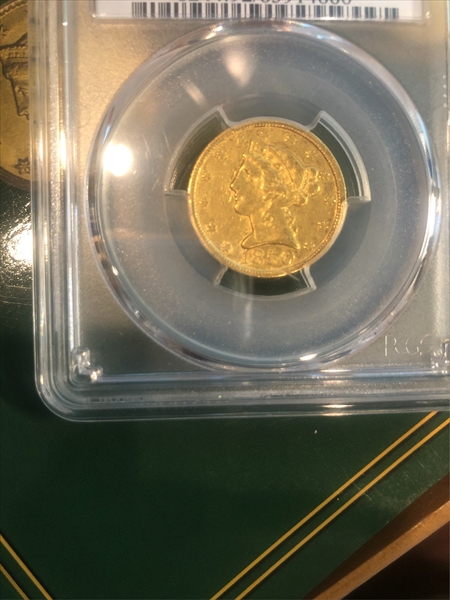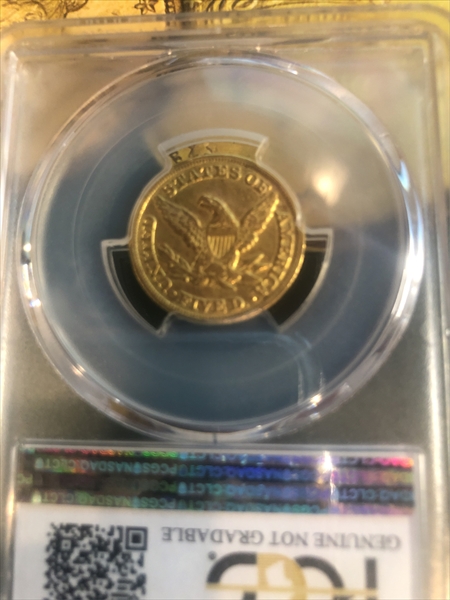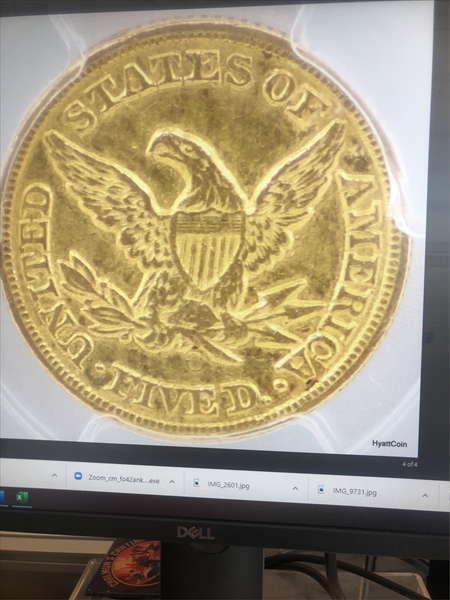1850-C $5 N1 认证号83914886, PCGS号8244
专家评论
Doug Winter
The mintage of Charlotte half eagles remained comparably high in 1850. This is one of the more available dates from this era and some very nice examples have survived.The 1850-C is one of the more common half eagles from the Charlotte Mint. It can be found with relative ease in Very Fine and Extremely Fine grades and is only moderately scarce in the lower AU grades. It becomes very scarce in properly graded AU55 to AU58 and is very rare in Uncirculated with, at most, a dozen known. I know of at least six separate coins that grade MS63 or better by today’s standards.
STRIKE: The quality of strike varies greatly on this date. The typical piece shows better detail on the obverse than on the reverse. The obverse is nearly always weak on the curls below BERT in LIBERTY and on the curl blow the ear. The stars are mostly well defined, but there may be incomplete areas on the denticles. The date itself, as on the Philadelphia and Dahlonega half eagles of this year, is somewhat weakly impressed. The reverse is generally weak on the legs of the eagle, the top of the shield and the lower part of the neck feathers. Some better struck pieces exist and these are generally worth more than the typical strike.
There are a number of 1850-C half eagles known with weak or very weak mintmarks. These are not worth as much as coins with bold mintmarks...the collector should carefully inspect the reverse of all 1850-C half eagles to be certain that the mintmark is bold. Weak mintmarks are also seen on 1853-C and 1854-C half eagles.
SURFACES: I have seen a number of 1850-C half eagles with mint-made planchet defects. These marks, which are usually small, are most often seen in the obverse fields and along the inside of the eagle’s wings. It is very hard to find pieces that do not have heavily abraded surfaces.
LUSTER: On some of the higher quality surviving pieces, there is attractive thick, frosty luster. A very small number exist that are semi-prooflike. Most 1850-C half eagles, however, have been cleaned or processed at one time and have impaired luster as a result.
COLORATION: The color on original pieces tends to be very attractive. It ranges from deep green-gold to lighter yellow-gold. It used to be reasonably easy to find an 1850-C half eagle with good color but most examples are now bright and lack any character as a result of having been cleaned.
EYE APPEAL: Nice, original high grade 1850-C half eagles are among the most attractive Charlotte half eagles from the 1850s. Such coins, unfortunately, are becoming harder and harder to find every year. The typical “commercial quality” piece is a bit softly struck, has heavily abraded surfaces and shows disturbed luster from having been cleaned.
DIE CHARACTERISTICS: The prominent die characteristics for this issue depends on the die variety.
DIE VARIETIES: There are a total of four die varieties known. As a result, this is one of the more interesting Charlotte half eagles.
Variety 1 (formerly Variety 14-F): The 1 in the date is very close to the bust while the 0 is closer to the denticles than to the bust. The reverse is the same as seen on the 1849-C Variety 1 and 1851-C Variety 2 half eagles. On all known examples, there is a small unfinished area on the reverse in the space between the eagle’s left wing and the branch. In addition, all examples I have seen have the same reverse crack as seen on Variety 1 of the 1849-C half eagle, die state II.
Variety 1 is scarcer than Varieties 2 and 4 but can be located with patience.
Variety 2 (formerly Variety 15-F): The obverse is the same as on Variety 1. The mintmark location, though similar to that seen on Variety 1, differs to the extent it is placed further to the left and is centered over the left serif of the V in FIVE. This variety has a die crack just past the bottom of the I in FIVE and extends past the F. It eventually develops into a retained cud. The crack continues along the left border, joining the edges of the letters in UNITED and ending at the tip of the left wing.
Variety 2 is seen less often than Variety 4, but it is more available than Variety 1 and 3. Examples with large retained cuds are of interest to error collectors and command a premium.
Variety 3 (formerly Variety 15-G, Die State I): The obverse is the same as for Variety 2. The mintmark is large and its right edge is over the middle serif of the E in FIVE. The left edge of the mintmark is over the right serif of the V. The serif of the mintmark is close to the branch and the mintmark itself is three times closer to the feathers than the V.
Variety 3 is more difficult to locate than variety 2 and 4, but it is not rare.
Variety 4 (formerly Variety 15-G. Die State II): The 1 in the date is slightly further from the bust than on the other three varieties. A thick die scratch on the L in LIBERTY quickly distinguishes this variety and it is not seen on the other 1850-C obverses. The mintmark is nearly identical to Variety 3 in terms of location. However, given that the Variety 4 mintmark was lightly punched into the working die, it is always weak or very weak. On some examples, it is nearly invisible.
Variety 4 is the most common variety of the year.
David Akers (1975/88)
This date often comes with such a weak mintmark that on some specimens it is barely visible. This is one of the more common Charlotte Mint Half Eagles but it is still very scarce in all grades and genuinely rare in almost uncirculated or uncirculated condition. Fine to EF are the normally available grades.PCGS #
8244
设计师
Christian Gobrecht
边缘
Reeded
直径
21.65 毫米
重量
8.36 克
铸币数量
63591
金属成分
90% Gold, 10% Copper
更高评级数量
210
评级较低的钱币数量
0
地区
The United States of America
价格指南
PCGS 数量报告
拍卖 - PCGS 评级的
拍卖 - NGC 评级的
稀有性和存量估计 了解更多
| 所有评级 | 700 |
| 60或以上 | 17 |
| 65或以上 | 0 |
| 所有评级 | R-5.6 |
| 60或以上 | R-9.2 |
| 65或以上 | R-10.1 |
| 所有评级 | 109 / 112 |
| 60或以上 | 84 / 112 TIE |
| 65或以上 | 1 / 112 |
| 所有评级 | 153 / 218 TIE |
| 60或以上 | 113 / 218 TIE |
| 65或以上 | 1 / 218 |
状况普查 了解更多
| #1 MS64 PCGS grade |
| #1 MS64 PCGS grade |
| #1 MS64 PCGS grade |
 #4 MS63 PCGS grade
#4 MS63 PCGS grade
|
| #4 MS63 PCGS grade |























